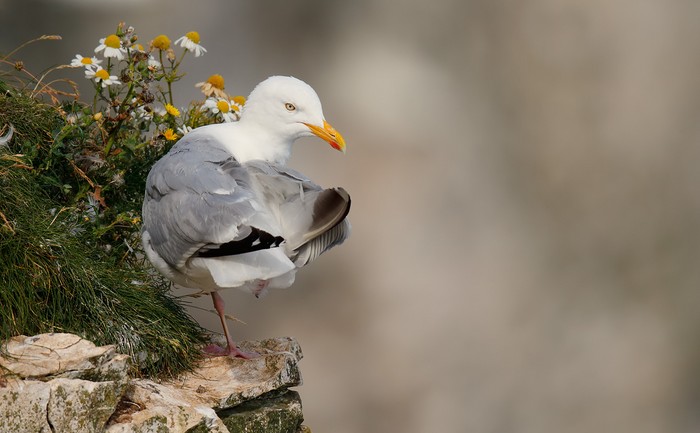Three gulls and an island
On Scotland’s Isle of May new research reveals how Lesser Black-backed, Herring and Great Black-backed Gulls divide their feeding grounds.

Tracking competition in a crowded world
How do closely related and co-existing species share resources in a landscape increasingly shaped by humans? A new study by Nina O’Hanlon and colleagues offers an insight into this question by examining the foraging behaviour of three large gull species - Lesser Black-backed Gull, Herring Gull, and Great Black-backed Gull - breeding in the same colony on the Isle of May in Scotland. Using GPS tracking devices on 67 individuals, the researchers uncovered both striking similarities and subtle distinctions in where and how these birds feed during the breeding season.
Although all three species showed considerable overlap in habitat use, there were signs of partial niche partitioning through differences in foraging range, direction of travel, and habitat preferences. These distinctions, the study suggests, may help reduce interspecific competition - but only to a point.
Going the distance: differences in foraging ranges
Lesser Black-backed Gulls were found to travel significantly further than the other two species, with foraging trips averaging nearly 35 km and sometimes extending over 270 km from the colony. In contrast, Herring Gulls averaged 22 km, and Great Black-backed Gulls had the shortest ranges, often remaining within 12 km of the colony. Spatial analysis showed that core foraging areas for each species were largely distinct, even though home ranges overlapped.
This spatial separation may reflect competitive hierarchies, with the larger and more dominant Great Black-backed Gulls able to exploit resources closer to the colony, while Lesser Black-backed Gulls are pushed further afield. However, all three species largely foraged in the same general region, particularly to the north and south of the Isle of May, focusing on terrestrial and coastal habitats.
Human-influenced choices: habitat selection patterns
The study found that all three gull species showed a preference for habitats influenced by human activity, including landfill sites, harbours, and agricultural land. However, there were clear differences. Great Black-backed and Herring Gulls strongly selected for landfill and coastal sites. Herring Gulls also showed a moderate preference for urban areas. In contrast, Lesser Black-backed Gulls made more extensive use of agricultural habitats, though their statistical “selection” for this habitat was weak because it was so widely available.
Marine habitats were surprisingly underused by all species, suggesting a reduced reliance on natural marine prey. This likely reflects both decreased availability of fishery discards and the relatively high competition or energetic costs associated with marine foraging.
Individuals drive the trends
While the population-level data highlighted general patterns, much of the selection for landfill, harbour, and urban habitats was driven by a small subset of individuals. Most gulls were generalists, using a variety of habitats rather than specialising in one. Notably, Great Black-backed Gulls showed the most individual specialisation, with some birds foraging almost entirely within the colony by depredating seabirds and rabbits.
These individual-level findings emphasise the importance of not treating species as ecological monoliths. Within a species, some birds may be highly specialised in human-dominated environments while others rely more on traditional foraging sites.
Implications for conservation and management
This partial but limited niche partitioning has serious implications for conservation and gull management. As human-modified habitats change - through closure of landfill sites, increased urban development, or shifts in agricultural practices - competition between these species may intensify. Since most habitats used by the gulls are linked to human activity, future changes could displace individuals from preferred foraging areas, increasing both intra- and interspecific conflict.
The authors suggest that these dynamics should be considered in licensing decisions for gull control and when assessing the impact of developments such as offshore wind farms. GPS tracking of sympatric species can help predict where such conflicts may arise and support more informed, targeted management strategies.
This study paints a complex picture of coexistence and competition among generalist gulls in a human-altered world. While spatial and habitat differences provide some relief from direct competition, the high degree of overlap - and dependence on anthropogenic habitats - points to a potentially fragile equilibrium. As land use and resource availability continue to shift, the survival strategies of these familiar seabirds will need to evolve accordingly.
July 2025
Share this story







